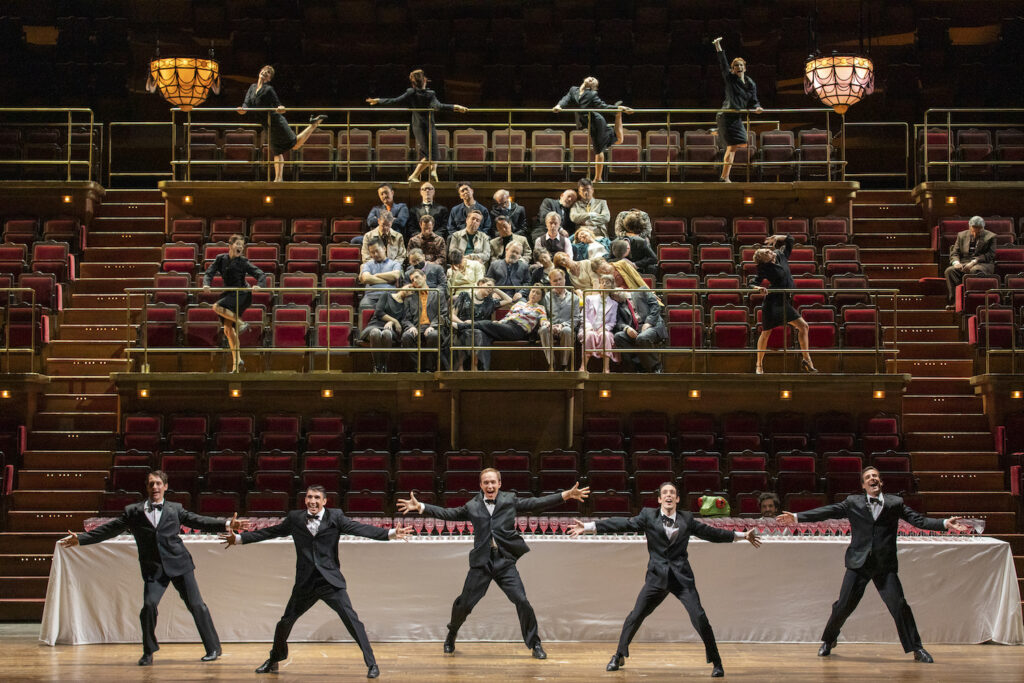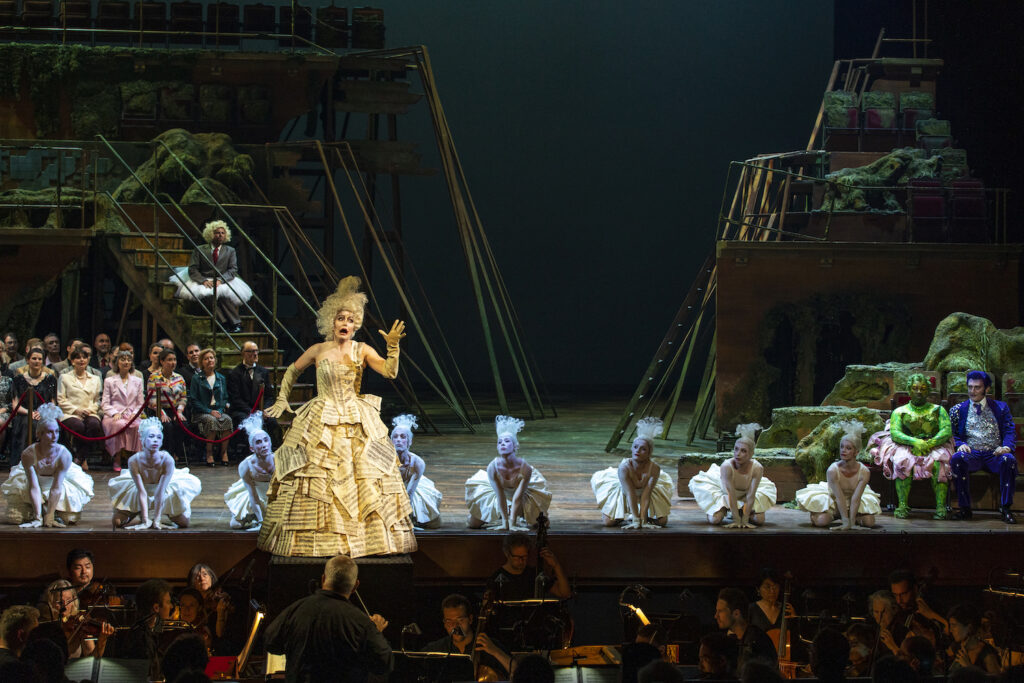The French are indeed “frogs!” Rameau’s Platée (1745) as told by stage director Laurent Pelly is yet another proof. This production appeared first in 1999, then again in 2005, 2007 and 2015. And just now, yet again with conductor Marc Minkowski’s famed Les Musiciens du Louvre. It is a truly vintage production, grand cru indeed.
From the downbeat of Rameau’s sumptuous overture à la French Baroque opera we see on the stage the mirror of architect Charles Garnier’s auditorium (where we are sitting). In successive musical blocks we see an audience being seated (dressed like us), who slowly take life, abstractly, as frogs, aided by a number of usherettes who will make some witty balletic moves à la French Baroque opera. Meanwhile more audience is seated, the 27 strong chorus from the Opéra de Paris who come together finally into a solid block. They will have much to say, quite formally and magnificently à la French Baroque opera.

Essentially there is a vain, deluded, middle aged frog, Platée (see lead photo), who thinks she is gorgeous, sure to capture the attentions of the god Jupiter (who will come to the frog pond in various disguises). Frogs dance. Jupiter who travels with a muse and a tragedian, a retinue of lesser divinities plus personified Amour and personified Folly, pretends to fall in love with her and proposes marriage. La Folie then sings a huge aria à la the then wildly popular Italian opera — and then sings some more. Satyrs and nymphs dance. And then dance some more. Bride-to-be-Platée, waiting patiently for “Hymen et Amour,” gets bored at these wedding divertissements.
The raging Juno, Jupiter’s jealous heavenly wife, arrives and sings furiously à la French Baroque opera. She lifts the wedding veil, only to expose an ugly frog. Everyone laughs. Jupiter and Juno return to Valhalla, the humiliated Platée jumps back into the pond. The problem is that we had come to love Platée, played in this fifth edition by American tenor Lawrence Brownlee as a totally believable, vain frog who sings her many airs like a goddess.
Pit this against Platée’s nemesis, La Folie, who gets completely carried away by her arty virtuosity, leaving Platée quite alone in a far more complex emotional world.
It is a mean opera.
La Folie was sung by French soprano Julie Fuchs, an accomplished comedienne who sang the role also in the 2015 edition. Though I found her recent Susanna (Nozze) in Aix to be dazzling, I was not convinced by these Parisian pyrotechnics. The very first (1745) Folie was, like Mme. Fuchs, a light, high soprano. Rameau chose a heavier voiced tragedian for the opera’s revival a few years after its premiere. Of great interest will be the final two performances of this edition to be sung by Egyptian, San Francisco finished, soprano Amina Edris who is of much darker voice.

Tenor Lawrence Brownlee is a famed Rossini/bel canto tenor, of quite beautiful voice. He easily negotiated Rameau’s baroque lyricism, though I found his sound smaller than usual. The program booklet makes no mention of a transposition to accommodate Mr. Brownlee’s slightly lower range. His Platée was of consummate charm.
Platée is normally cast with a haute contre tenor (a naturally high voice of vocal range similar to a castrato). The first two editions of this production were sung by famed French haute contre tenor Jean-Paul Fouchécourt (who sang the role in the 2007 Santa Fe Opera version of this production as well). He is a character tenor (not a leading/romantic tenor) thus he displays the attendant vocal and comedic characteristics of that voice.
Mr. Fouchécourt was also the Platée for a contemporized Mark Morris Dance Company/New York City Opera production that toured the U.S. in 2001, which I saw in Orange County (California). In stark contrast to Mark Morris’ rough-trade gays, cross dressers, drunkards and showgirls, in Paris there were 14 dancers (presumably from the Opéra de Paris ballet) staged by famed Italian choreographer Laura Scozzi, dancers who assumed many abstract guises — an audience [us], satyrs and nymphs, ballerinas and, of course, frogs in absolutely wacky, highly balletic moves that punctuated the opera’s airs and choruses.

This production marked the the beginning of Laurent Pelly’s international career, always promulgated by the bold primary colors of his set designer Chantal Thomas. In productions I have seen Mr. Pelly’s characters have been highly abstracted from any normal reality, freed to assume an independent musical life. Pelly himself imagines their costumes.
Marc Minkowski’s Les Musiciens du Louvre is one of the France’s artistic treasures. For this production there were two flutes, six oboes, four bassoons plus percussion and keyboards, and a huge number of strings. The sound was rich and smooth, the performance highly polished indeed, this fifth time around. Conductor Marc Minkowski obviously has great affection for this score, reveling in Rameau’s liberal sprinkling of onomatopoeiae — donkeys. owls, birds, frogs, etc., while basking in the mighty symphonic richness of Rameau’s overtures and interludes.
Michael Milenski
Cast and Production credits:
Platée: Lawrence Brownlee; La Folie: Julie Fucks; Cithéron: Nahuel di Pierro; Momus: Marc Mauillon; L’Amour: Tamara Bounazou; Mercury: Reinoud Van Mechelen; Jupiter: Jean Teitgen; Juno: Adriana Bignagni Lesca. Les Musiciens du Louvre, Choeurs of the Opéra national de Paris. Conductor: Marc Minkowski, Mise en scène/costumes: Laurent Pelly, Scenery: Chantal Thomas; Lighting: Joël Adam; Choreography: Laura Scozzi. Opéra Garnier, Paris, France, June 21, 2022.
All photos copyright Guergana Damianova, courtesy of the Opéra national de Paris